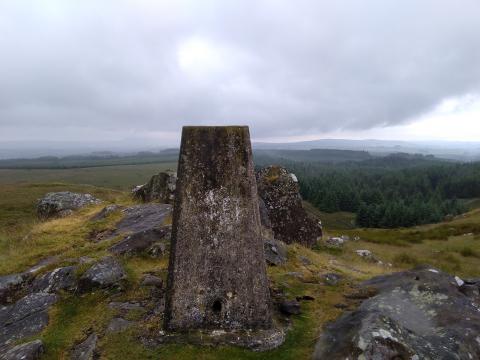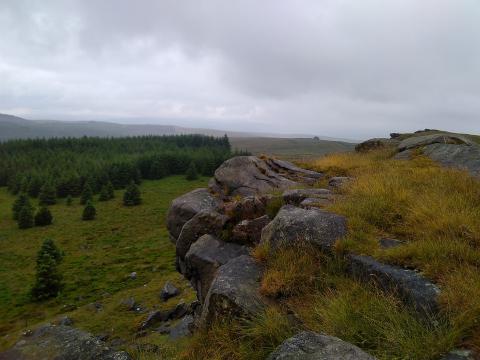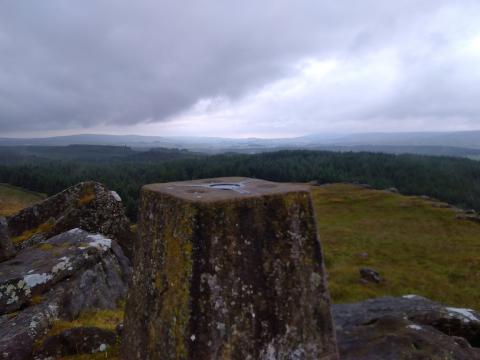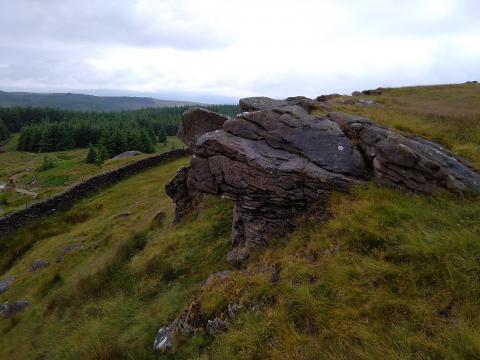Whelpstone Crag

Last weekend, I climbed Whelpstone Crag, a hill overlooking Gisburn Forest. Although not the highest of climbs, its panoramic views of forest and moorland were sufficiently rewarding for the trouble it gave. The day was dull and damp, and mists could be seen swirling through the trees below. The flies were delighted by our presence as we disturbed their slumber in the woods; dozens buzzed about us as we passed through the dripping trees, they attempting to make us their feast.
A number of large gritstone rocks make up the Crag, some of which had upon them ancient, man-made cup marks. Yet it was the hill's name which intrigued me most. A whelp is either a derogatory expression for a young man, or the progeny of some dangerous animal. In the AV, there are ten references to the whelps, or cubs, of the lion. For example, Genesis 49:9
Judah is a lion's whelp: from the prey, my son, thou art gone up…
A final two references refer to the young of bears, for example:
…as a bear robbed of her whelps in the field. (2 Samuel 17:8).
Our crag is unlikely to have been a place where lions and bears sired their young, but the University of Nottingham suggests the placename was first recorded as Hwelpestanes in 1189, meaning ‘cub stones’. If not the cubs of lions and bears, then what? Aybes & Yalden’s Place-Name Evidence for the Former Distribution and Status of Wolves in Britain (1995), suggest that ’'whelp’ place-names…imply the pups of wolves, dogs or possibly foxes’. They argue that ‘Whelpstrother, Whelprigg and Whelpstone Crag are all accepted as referring to wolf cubs. All are in likely habitats, in mountainous country and at higher altitudes’. In other words, our crag was once a place where wolves bred and lived. There are no longer wild wolves in England, the last ones being seen during the reign of Henry VII (1485–1509). By this time, ’wolves had become limited to the Lancashire forests of Blackburnshire and Bowland, the wilder parts of the Derbyshire Peak District, and the Yorkshire Wolds’.
I rather like wolves, and their reintroduction to parts of Scotland and the American national parks has worked wonders for restoring ancient habitat. That said, I am glad that it was only flies that desired us for food. In scripture, wolves are often used as metaphor for dangerous and unscrupulous enemies of God and His people. For example, in Matthew 10:16, the Lord Jesus said “Behold, I send you forth as sheep in the midst of wolves”. In Acts 20:29, Paul warns the Ephesian elders of hathering wolves- predators who would seek to destroy the church.
On Saturday, as I stood atop Whelpstone Crag, there was little danger of being attacked. Once, our medieval ancestors would have been reluctant to ascend the hill for fear of being preyed upon. The threat is removed, the terrifying wolves all gone. One day, there shall be no opposition and hostility towards, or persecution of, Christian people. Those snarling wolves will be pacified or removed. Those high places of spiritual hatred will be filled with the knowledge of the Lord, as the waters cover the sea, for the wolf also shall dwell with the lamb, and the leopard shall lie down with the kid.
Be bold, therefore. You are on the winning side.



- Log in to post comments


 Sunday Worship 10.45am & 6.00pm
Sunday Worship 10.45am & 6.00pm